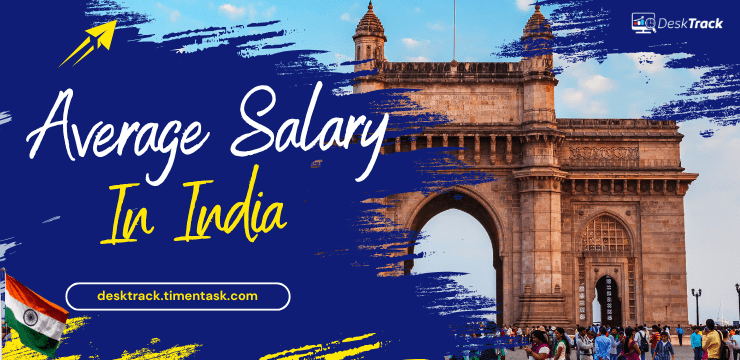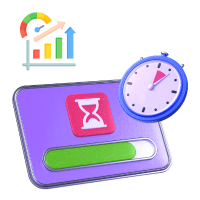
Want to know the average salary in India, or wanna know what the minimum cost of living in the country is? We have got you covered. The average salary in India depends on different factors. The major ones are educational qualifications and work experience. Other factors that play a major role in determining the average salary of employees are gender, age, city, and last drawn salary, etc.
In this blog, we will answer your queries, such as “What is the average salary in India?” What are employee benefits in India? What is the median income in India, and multiple other similar questions?
So, let’s begin the exploration.
Average Salary in India
The average salary in India in 2025 is approximately 29834 (Indian Rupee) per month, i.e., 358000 INR per annum.
The average salary is a bracket between a nation’s average lowest and average highest salaries. In India, the average monthly salaries of people also include transportation, housing, and other essential benefits. Based on that, the monthly salary in India approximately ranges between 8080 INR and 143000 INR. However, the average salary of individuals can vary depending on their educational levels, the cities they live in, and the work experience they have.
Read Also: 26 Different Time Management Techniques that Still Work in 2025
Minimum Wages in India
The minimum wage accumulates the minimum salary that an Indian employer is entitled to provide their employees daily. Contrary to some other countries, India has different rules and regulations that bind employers with minimum wage restrictions.
The Minimum Wages Act 1948, subject to the provisions of the Code on Wages Act 2019, notified in August 2019, rules minimum wages in India. Unlike other countries, India does not have a single minimum wage for the entire nation. As India is a federal nation, the minimum wages differ from state to state.
For example, the daily wages in India for an unskilled worker are 612 INR in New Delhi, while in Bihar, it’s 304 INR. To identify how much you have to pay your daily wage workers according to your pay period, using time tracking software is a wise choice.
Comparing the Median Salary in India with the Average Salary in India
Make your workday more productive
Time tracking and work management can help you reach your goals
faster.
According to the average Indian salary and as per the report “ State of Inequality in India”, 90% of Indians earn less than INR 30,000 per month, which is less than the average salary in India.
So, now, what to use to understand this disparity? Let us understand the concept of the median income in India. In simple terms, the Indian median income refers to the middle salary value between the highest and the lowest salaries.
The median salary in India is 27,300 INR. This means that 50% of the Indian population earns less than this amount, and the other half earns more than this figure.
Now, let us understand the similarities and differences between the average and median salaries.
Both average and median salaries indicate the central tendency of a salary set, but with different approaches. The average salary is the amount that is standard for any employee, whereas the median salary is the middle value of any salary series arranged in descending order. It represents a particular point of distribution that cannot be pulled below or above.
Employee Benefits in India

To live a comfortable life in India, you also need some bonuses on top of your base salary. Thus, the common employee benefits in the country are gratuity, health insurance, life insurance, travelling allowance, etc. Also, multiple startups offer their employees investment and partnership opportunities as well.
Employee benefits in India are categorised into two different categories:
1. Statutory Benefits for Employees
Statutory employee benefits are mandatory for employers to provide. Different acts and regulations govern statutory benefits for employers in India, like:
- Employees’ Provident Funds and Miscellaneous Provisions Act 1952
- The Maternity Benefits Act, 1961
- The Employees’ State Insurance Act, 1948
Some statutory employee benefits in India include:
- Gratuity
- Insurance
- Provident Fund
- Bonus
- Maternity Benefits
2. Discretionary Benefits for Employers
There is no obligation on employers to provide discretionary employee benefits. It is totally up to their will whether to provide employees with these benefits or not:
- Health and Life Insurance
- Transportation
- Accommodation
- Mental Health Benefits
- Gym Facilities
Education-Wise Average Income in India
The hike in wages in India also varies according to the experience level of the candidate. So, if you want to get a job there, these statistics will be helpful for you.
| Experience in Years | Average Indian Salary Progression |
| 2-5 | +32% |
| 5-10 | +36% |
| 10-15 | +21% |
| 15-20 | +14% |
| 20+ | +9% |
Profession-Wise Average Salaries in India
As we have already mentioned, an individual’s profession and the industry they work in are among the factors that determine their average salaries in the Indian subcontinent. Let us see profession-wise average salaries in India in the table below:
| Profession | Monthly Indian average salary in USD |
| Program Manager | 1754 |
| Healthcare Consultant | 1591 |
| Project Manager | 1492 |
| Life Sciences Consultant | 1392 |
| Data Scientist | 1094 |
| HR Manager | 795 |
| Chartered Accountant | 793 |
| Software Engineer | 596 |
| Data Analyst | 596 |
| Java Developer | 497 |
| Restaurant Manager | 445 |
| Legal Advisor | 424 |
| Journalist | 375 |
| Interior Designer | 298 |
| Mechanical Engineer | 248 |
| Accountant | 238 |
| Content Writer | 238 |
| Teacher | 238 |
| Graphic Designer | 238 |
| Data Entry Operator | 181 |
Location-Wise Average Salary in India
The monthly Indian salary average also depends on the location where you work. For example, people working in New Delhi earn more on a monthly average than people working in Pune. Similarly:
| Location | India Average Salary Per Month (in INR) |
| Bangalore | 34700 |
| Pune | 34100 |
| Mumbai | 36700 |
| Vadodara | 30400 |
| New Delhi | 36600 |
| Bhopal | 31700 |
| Kolkata | 35100 |
| Chennai | 33900 |
| Madurai | 28100 |
| Kanpur | 32800 |
Read Also: 32 Good Workplace Habits To Incorporate into Your Daily Routine
Comparing Average Salary in India with the Rest of the World
The average salary in India is lower than in most developed countries. However, the cost of living in India is also lower than in these countries.
1. Comparing India’s Average Salaries with Developed Countries
Let us see how much higher or lower the average salary in India is in comparison to the average salaries in different developed countries:
| Nation | Average Salary Per Month | Comparison to Average Income in India |
| UK | $8092 | +180% |
| USA | $7900 | +179% |
| Norway | $5,696 | +172% |
| Germany | $4,493 | +165% |
| Austria | $4470 | +165% |
2. Comparing India’s Average Salary with Evolving Economies
Having compared the average salary in India with the average salaries of different developed countries, let us now compare the same with the average salaries of different developing countries using the table below:
| Nation | Average Monthly Salary | Comparison to Average Wage in India |
| Thailand | $748 | +149% |
| Philippines | $587 | +69% |
| Vietnam | $508 | +54% |
| Egypt | $2,949 | +31% |
| Pakistan | $387 | +17% |
3. Comparing India’s Average Salary with Economies in Transition
According to the World Economic Situation & Prospects Report, the remaining category is economies in transition. So, let’s view how they compare to the average monthly salary in India.
| Nation | Average Monthly Salary | Comparison to the Average Salary in India in USD |
| Georgia | $2191 | 134% |
| Russia | $1392 | 106% |
| Albania | $923 | 73% |
| Kazakhstan | $903 | 71% |
| Ukraine | $845 | 66% |
Conclusion
Throughout the text, we explored different aspects of the average salary in India. We found that although the average per-month salaries in India are lower than in many developed and developing countries, the cost of living here is also lower than in these countries.
We also discovered that the average salary of an individual differs from one state to another in India and is dependent on different factors such as experience, education, and more. Other than average salaries or minimum wages governed by regulations, employees in India also have mandatory and discretionary employee benefits to better their lives.
Frequently Asked Questions (FAQ)
Q. What is the Average Salary in India?
Ans. The average salary in India in 2025 is approximately 29834 (Indian Rupee) per month, i.e., 358000 INR per annum.
Q. What are the Benefits Given to Employees in India?
Ans. Employees in India receive 2 types of benefits from employers.
- Statutory benefits such as gratuity and insurance.
- Discretionary benefits such as transportation and accommodation.
Q. How Does the Average Indian Salary Stands Against the Evolving Economies’ Salaries?
Ans. When comparing the average salary in India per month, we find that it is lower than in most emerging economies. While the average salary in India is $336. Evolving nations earn more, such as:
- Thailand- $748
- Philippines – $587
- Vietnam- $508
- Egypt – $2,949
- Pakistan – $387
Q. How Does the Average Indian Salary Stands Against Developed Nations?
Ans. The average Indian salary per month is even lower than in most developed countries. The figures say it all.
- UK- $8092
- USA- $7900
- Norway- $5,696
- Germany – $4,493
- Austria – $4470
Q. What is the Average Indian Salary for Various Professions?
Ans. Here are the average monthly salaries in the top 5 professions in India.
- Program Manager – $1754
- Healthcare Consultant – $1591
- Project Manager – $1492
- Life Sciences Consultant – $1392
- Data Scientist- $1094







